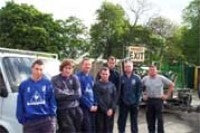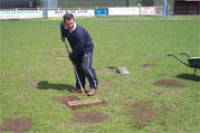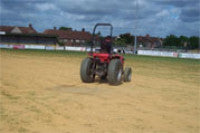Back on the tools
Back on the tools
I still remain good friends with my previous employer; I've spent nearly fifteen years of my life working for him, either as a sub-contractor or on PAYE and there is a great deal of respect between us. At this time of year the amount of work that his contract company has is ludicrous, there is the changeover at many of the sports clubs and schools from winter to summer sport, but that is coupled with the end of season renovations required with all of the winter sport surfaces. The company maintain nearly forty annual maintenance contracts that range from Premier League football and Rugby through to private clubs and schools. So, with less than twenty staff on the books it's not surprising that resources become stretched.
Earlier in the spring and knowing what a busy time it would be, I had offered to help out with the renovations. In short I felt that I could get a few good articles written and keep my hand in at the same time. My ex-boss took me up on the offer and no sooner had the last game been played at Non-league Sutton United, that there I was, duly arriving early on a windy, yet sunny morning. It was
Like most non-league and club grounds the pitch has had its usual seasonal quota of training and games, topped up with the many end of season cup finals for every youth, Saturday and Sunday player in the local area. The lads reckoned that the pitch had seen about thirty matches in the final two weeks, and I honestly believed them as I wandered over what was left of the playing surface. It was probably best described as a lunar landscape; almost the entire diamond of the pitch was covered in shallow craters.
I contemplated the work ahead, and felt strangely drawn to the café across the road to perhaps give myself some more herbal refreshment prior to commencing work, but you know as well as I, 'that it don't get done thinking about it'. It was time to roll up my sleeves and bite the bullet.
Outside in the car park sat a fresh delivery of root zone, to be precise 15 tonnes of 70:30 sand/soil. I rued the fact that perhaps someone could have been around when the lorry driver arrived to see the load into the ground and tip his wares by the pitch instead of forty yards away the other side of the clubhouse.


It was at this time that the Cavalry arrived, with guess what- a tractor avec bucket. Good to see that organisation is still up to the usual standards. Chris 'the tractor' and I finished bringing in root zone and 
Another early morning start at Sutton, where I met Chris and we continued to grade out the piles of root zone to level. Level is everything with a playing surface, it almost doesn't matter that there is little or no grass as long as the surface runs true. I remember Blackburn Rovers winning the Premier League on Ewood Park that was almost devoid of grass.
By about ten in the morning the levels were reasonably well corrected, and I had also paid particular attention to the corners, the keepers foot holes on the six yard boxes and the linesman runs. I attached a Blec seeder to the tractor and travelled the pitch in a middle gear, just putting holes into the ground without any seed. My second and third passes were with seed in the hopper, ten bags (250kgs) in total; the passes in different directions allowing good seed distribution and hopefully a good take as most is buried in the holes produced by the sorrel spikes under the machine. The seed itself was a mix of three top Rye cultivars, specifically produced to withstand football pitch wear.
Once seeded, Chris and I loaded the top dresser to another tractor and started to load and spread the sixty tonnes of sand. The sand was an approved medium drainage sand, good for helping the drainage in a predominantly clay pitch. Again the sand was in the car park, but at least with machines it didn't take us more than about five hours to get it evenly spread on the pitch.
Chris then vertidrained the whole pitch to a depth of ten inches (250mm) at four inch centres (100mm), he had the machine on a setting for maximum heave which decompacted the ground, creating fissures and air space. Some of the sand from the dressing vibrates into these holes during the operation, but the drag matting at the end helps as well.

The only thing left was the fertilising which took us about forty-five minutes to apply using a cyclone pedestrian spreader. There were twelve bags (300kg's) of 9:7:7, a pre seed fertiliser.
